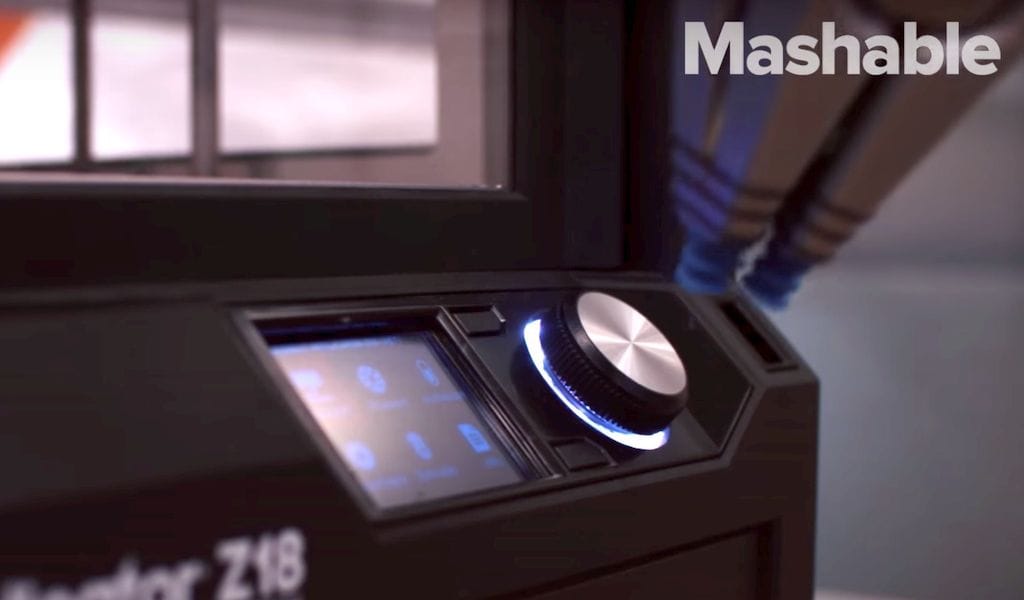
A video from Mashable shows a robotic prototype operating MakerBot 3D printers.
The robot, made by Kuka, one of the world’s biggest producers of industrial robots, attempts to take the place of the normally-required human operator. MakerBot 3D printers, like virtually all other desktop units, are designed to require human intervention to successfully operate.
Typical manual operation tasks include loading and unloading filament, removing completed prints and handling unexpected situations.
In the Mashable video, the Kukabots are seen to be removing completed prints, and the implication is that perhaps these robots or similar equipment could be used to operate desktop 3D printers.
I think this is nonsense.
This strategy makes little sense in many dimensions. Let’s examine some of the more obvious aspects.
First, cost. A typical MakerBot desktop 3D printer might be purchased at around USD$3,000, while a Kuka robot might range at USD$25,000 and up. Buying a robot at that cost to operate a much less expensive machine doesn’t make sense.
This is especially true when you realize the intermittent nature of required operation tasks suggests you could hire a human to do the necessary work at a very small fraction of the robot cost.
Perhaps there is a way to scale this up to gain efficiency? Maybe a robot could operate several 3D printers, spreading its huge cost across more machines? This would be limited by the robot’s reach, unless you mounted it on some kind of carriage system to bring it to the 3D printers – or mounted the 3D printers on a large carousel to bring the 3D printers to the robot. Either way, more expensive.
Far more expensive than that human you hired, who could, if tasked full time, look after dozens of 3D printers.
The Mashable video does not show the robot loading filament, which can be a tricky thing. In almost all the desktop 3D printers I’ve operated many things can go wrong during filament loading. Snags, misfeeds, tangles, stripping can all occur. I do not see how a robot could even detect such things happening, let alone recover from them.
Similarly, 3D print operations often fail, and they fail in a myriad of ways. Prints could come loose from the print bed, filament snags could corrupt a layer or three, print quality could be off, warping could occur, support structures may tip over before being engaged, excessive stringing from poorly-set parameters, wrong temperature settings, and, well, you get the idea. Almost anything could happen.
The best operations practice would be to stop prints that are heading south and restart them before print time and materials are wasted.
How is a robot to do that? How can it detect print quality problems? Equip it with a vision system and some kind of ultra-intelligent AI software that can visually determine whether a print is should be cancelled? I suspect that would be vastly more expensive than a human operator.
To me, adding an external robot is a dead end strategy. The correct answer is to build directly into the 3D printer the required functions – or even better, completely eliminate the need for operations tasks.
Consider the design of a print surface system that could automatically eject completed prints. If that feature existed then no human would be required to do the removal. What if this system also set up the print bed for the next print? That eliminates another task.
Filament loading can also be improved significantly. There are some systems I’ve used, like those from Stratasys’ professional lines that are extremely reliable. But others are quite touchy and require almost an artistic approach to making it work the first time. These could be improved to reduce the work to simply dropping a filament spool into the machine once in a while.
Detecting print problems is a bigger issue due to the sheer number of things that might go wrong. However, even these can be reduced by working on each failure scenario in turn and engineering features to avoid or reduce their occurrence. In the end you should end up with machines that fail so infrequently that only an occasional inspection is required.
While robots will continue as a standard within factories, will robots operate the 3D printers of the future?
Definitely not, because the 3D printers themselves will be the robots.
Via YouTube

